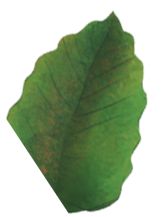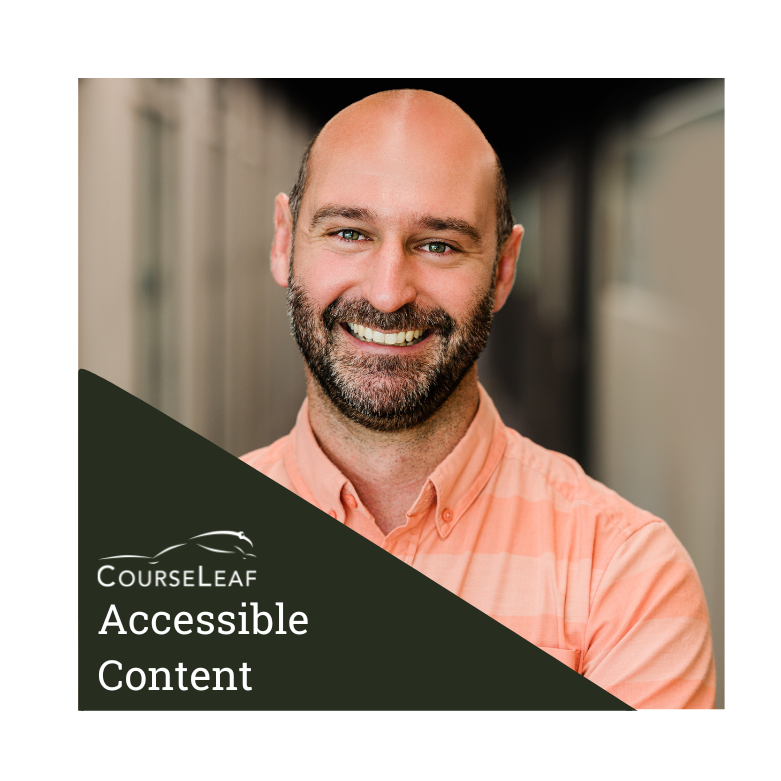ARTICLES AND INSIGHTS
Creating Accessible Content with CourseLeaf
The CourseLeaf academic operations platform and services are designed to be accessible and usable by all individuals, including those with visual, auditory, motor, or cognitive impairments. Learn more about CourseLeaf's accessibility tools and guidance with Craig Canfield, Director of Diversity, Equity, and Inclusion at CourseLeaf.

Accessibility plays a vital role in ensuring that all individuals have equal access to digital content. According to current estimates, approximately one in four Americans live with some form of disability. Disabilities can be either permanent or temporary, seen or unseen, and accessibility features benefit all users. By embedding accessibility into both design and content, CourseLeaf aims to remove barriers and create a more inclusive digital environment.
The Accessibility Landscape and Legal Guidelines
Web accessibility is governed by a range of guidelines and legal mandates, including an international set of standards known called the Web Content Accessibility Guidelines (WCAG) and federal laws such as Sections 504 and 508 of the Rehabilitation Act of 1973 and the Americans with Disabilities Act (ADA). These laws mandate that web applications, software, and digital content be made accessible by any entity receiving federal funding, relying on WCAG as the standard for web accessibility.
Our Approach to Accessibility
To promote accessibility throughout our products, CourseLeaf uses the Web Content Accessibility Guidelines (WCAG), version 2.2, as our internal benchmark for developing and designing our applications. WCAG outlines three levels of compliance: A, AA, and AAA. CourseLeaf seeks to achieve compliance at levels A and AA. Additionally, CourseLeaf complies with Section 508 of the Rehabilitation Act of 1973. Our conformance to these standards is documented through our Accessibility Conformance Reports (ACRs), which are created using Voluntary Product Accessibility Templates (VPATs), a standardized way of self-reporting conformance to accessibility guidelines and law.
Accessible Content Strategy
CourseLeaf does the hard work of creating an accessible web application, however the user also has a role to play in creating accessible content within our modules. To ensure what you publish on the web continues to be accessible, CourseLeaf recommends the following best practices related to accessible web content.
- Page titles should be short, descriptive, and unique to aid both navigation and screen reader comprehension. Headings and subheadings should be used to group and describe content logically, providing a clear hierarchy that mirrors user expectations.
- Linked text should be descriptive and meaningful, rather than using vague phrases like "click here" or "read more," so that each link communicates its destination or purpose. Avoid duplicating links on the same page where possible. The links themselves are made accessible by default through the use of color and underlining, aiding recognition for all users.
- Instructional text should be written to be clear and easy to understand, using simple language and explaining any required inputs or restrictions. Text should be kept concise, and acronyms should always be spelled out on first use. Long paragraphs benefit from being broken up using bullet points or numbered lists, which can be created using the built-in page editing tools in CourseLeaf that include necessary code that is parsed by screen readers.
- While tables may seem like a great way to organize information on a page, they often create usability and accessibility barriers. Tables should generally only be used to share correlated data, not just for ease of layout. Avoid complex tables with more than two heading levels, and consider breaking large or complex tables into multiple smaller tables, using page headings to organize. Always add tables using Insert/Edit Formatted Table feature in CourseLeaf’s Page Body Editor to ensure they are accessible to assistive technologies.
- Images should be used selectively and accompanied by alternative (alt) text that describes the image in a concise and meaningful way. This includes providing context for what is happening in the image. Flashing and rotating images should be avoided, as they can be disorienting or harmful to some users.
- Audio and audiovisual content should be supported by full transcripts, sound descriptions, and/or captions, as applicable, to ensure that all users can access the material equally.
CourseLeaf Tools That Support Accessibility
Fully utilizing the tools in CourseLeaf's Page Body Editor is recommended when creating or adding content to ensure accessible outputs. Users are advised to avoid editing HTML directly and to copy content as plain text to remove any hidden or incompatible code, using the formatting tools available in the Page Body Editor to format content. CourseLeaf's CAT Accessibility Report is another essential tool for ensuring accessibility. By scanning catalog content for heading errors, this tool helps users to identify and correct common accessibility issues.
Getting Real Results
Web accessibility is a shared responsibility at CourseLeaf, driven by a clear vision for digital equity and equal access and use of CourseLeaf products by all. Through its strategic focus on accessibility, CourseLeaf ensures compliance with legal standards and allows users to create digital content that is usable by the broadest possible audience. These efforts improve the user experience not only for individuals with disabilities but for all users, including those accessing content on mobile devices or in challenging environments.
By building accessibility into both design and content, CourseLeaf enhances usability and reduces legal risk for our clients. Our accessibility tools and educational opportunities empower CourseLeaf users to create accessible content efficiently and effectively.
CourseLeaf combines accessibility expertise, thoughtful design, and user-friendly tools to ensure that everyone—regardless of ability—can access and contribute to the digital world. Accessibility is essential for some and useful for all. This guiding principle continues to shape how CourseLeaf creates products that truly serve everyone.
Ready to Improve Accessibility Across Your Academic Content?
CourseLeaf helps institutions ensure their catalogs, curriculum, and syllabi meet ADA and WCAG standards. Connect with our team to learn how we can support your accessibility goals—without adding to your workload.



